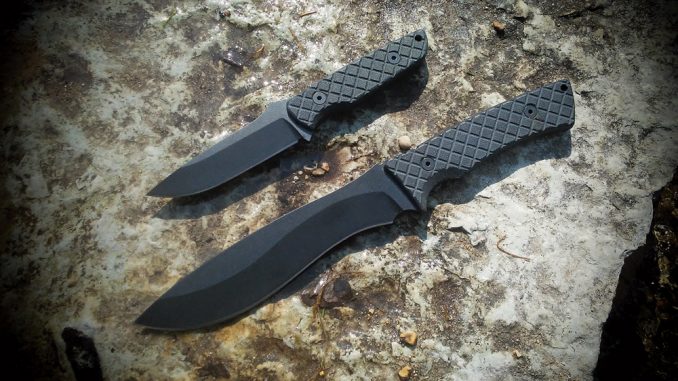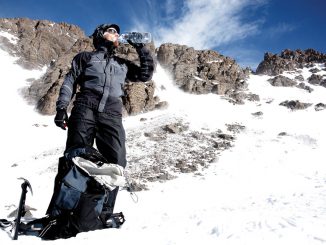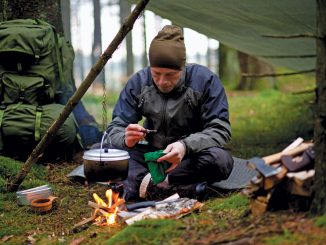
To say that I’ve been a fan of Spartan Blades for a while would be like saying Bob Uecker is a casual fan of baseball. Whenever I’d come across Spartan’s products at SHOT Show or a knife store, I lusted after them with a passion. Their fit and finish, ergonomics—just everything about them—were absolutely spot on. Unfortunately, I could never coincide the purchase opportunity with budget availability. Every time I got close to having the funds set aside, something would come up.
When Spartan Blades announced a new line of budget-friendly knives, my interest wasn’t just piqued; I was on pins and needles, waiting for more information.
The Silver Line consists of three knives, each of them intended for a specific market or use. The Alala is Spartan’s fixed-blade EDC (everyday carry) model. The field knife is called the Damysus. Then, there’s the chopper, the Machai. All three are Spartan models through and through. But, rather than being produced in house, the company’s teamed with KA-BAR. Spartan is providing the designs, and KA-BAR is doing the “heavy lifting,” so to speak.
Spartan sent over the Alala and the Machai for review. Let’s take a look.
Alala
In Ancient Greek, “Alala” means “war cry,” and that’s a pretty good designation. From the moment you pick it up, this knife is ready to ride into battle without faltering or hesitation, even if the fight is just against a pile of cardboard boxes that need to be broken down.

This is the Silver Line entry that’s geared toward everyday use. Therefore, it’s the smallest in the group, with a blade that’s fewer than 4 inches long and an overall length just shy of 8 inches. My first impression was that right out of the box, the knife was very solid and robust without being ridiculously overbuilt. Weighing a bit fewer than 5 ounces, it doesn’t feel like a boat anchor either.
The Alala’s handle is designed in such a way that it inspires great confidence for a positive grip in all conditions. First, the scales are made of canvas Micarta, which is a popular handle material for a reason—it’s tough as nails. The scales are textured and also deeply checkered. On top of that, they’ve contoured the handle with a very comfortable finger indent. Unlike some lesser-quality knives from other manufacturers, Spartan’s gone the next step and radiused the indent, smoothing out any potentially rough or sharp edges. There’s jimping on the thumb ramp, but it isn’t so aggressive as to be uncomfortable.

The Alala is 0.1875 inch thick. It’s strong without being ridiculously overbuilt.

At home in the wild, as well as in urban areas, the Alala is an ideal companion.
The balance point is right where the forward-most screw is placed in the handle (about even with the middle of the finger indent).

The textured handle on the Alala lends a comfortable and positive grip in any conditions. (Photo: Spartan Blades)
The flat-ground blade extends 3.75 inches. It’s a drop point—one of the most common and eminently useful blade profiles around. A black powdercoat protects the 1095 Cro-Van steel. The edge arrived sharp, although not quite hair-popping.
The Alala’s sheath is injection molded and quite well-designed. It has numerous attachment points, allowing the user to strap it just about anywhere. There’s also a retention strap that allows for belt carry. Something I really appreciate about this sheath is the thumb-activated retention lever. As you wrap your fingers around the knife handle, your thumb instinctively finds this lever. Slide it up, and the knife is freed. Otherwise, it’s very secure in the sheath.

The release lever on the sheath of the Alala, shown here, as well as that on the Machai, is instinctive to use and works very well at retaining the knife.
Slicing it Up
You can always tell you’ve walked into the work space of a knife reviewer because of all the miscellaneous, half-destroyed stuff lying around!

It took a couple of swipes, but the thick fabric belt wasn’t an insurmountable task for the Alala.
To check the Alala’s cutting ability, I grabbed a thick fabric belt. This is something I picked up at a thrift store a year or so ago, and I’ve been slowly nipping away at it ever since. It took two passes with the Alala to make each cut. I think that with a few passes on a strop, the edge would’ve been much keener, but my custom is to review each knife as it arrives in the box. That said, the knife was very comfortable, even when I gave it some force to make the cuts. I didn’t experience any hot spots during this test or the subsequent experience I had using the knife as my primary carry blade for a couple of weeks.
What’s the Point?
I’m not a torture-test reviewer; I don’t believe in pounding a knife through a cement block just to see how badly its edge will get banged up. Instead, I try to concentrate on how the knife would normally be used. However, while we all know we’re not supposed to pry things with the point of a knife, we also all do it, at least once in a while. So, I wanted to test the Alala and see how it would hold up.

The Alala pried up a substantial piece of wood and was completely undamaged. Nice!
I grabbed an old piece of 2×4. Using a hammer, I tapped the knife into the wood about a half-inch or so. Then, I slowly and steadily levered the knife out to the side, prying up a big chunk of wood. The knife point was entirely undamaged. This speaks volumes about its design, as well as the quality of its construction.

A prying test always makes the author nervous, because he’s had knives break once the prying begins.
Machai
Back to the Greeks: In their mythology, the Machai were the spirits or demons of battle. They would accompany gods such as Ares into war. I have little doubt that if they’d had access to the Spartan Blades inventory, one of these knives would have ridden on the hip of each of them!

The Machai is a very handsome knife—but it’s not so pretty that you’ll be afraid to get it dirty. (Photo: Spartan Blades)
Likely the first thing noticed about the Machai is its recurve blade profile. This blade shape has been popular for many years, particularly on knives intended for field use. The “S” shape of the blade effectively lengthens the cutting edge without increasing the size of the knife. It also provides a distinct advantage when you’re using a base-to-point movement to cut, such as when you’re blazing a trail. The shape of the blade pulls the edge across the material.
In addition to clearing tall grass or shrubbery, it works very well when cutting rope and other tasks that require pulling the knife toward you to complete the cut. On a larger knife such as the Machai, this shape also puts the weight of the blade forward, lending strength and power when chopping.

Owing to the hardness of the seasoned wood, it took a little work, but the Machai performed flawlessly while chopping.
The Machai is currently the largest knife in the Silver Line, with an overall length of 10.5625 inches and a blade reaching 6.625 inches. It’s a solid 10.7 ounces, giving it plenty of heft—but not enough to make it feel like dead weight on the hip.
Structurally, it’s very similar to the Alala. It has the same type of textured grip and radiused finger indent. The handle is a bit larger, of course, running about 5 inches. There’s a small section of jimping on the handle just behind the blade.

The jimping on the Machai is thick and rounded, giving you plenty of traction without being uncomfortable.
The sheath has the same type of lever release as the Alala. It also has numerous attachment points for either cordage or straps, as well as a generous belt loop. The carry position can be reconfigured very easily: Simply unscrew four screws, and the belt loop platform can be removed and adjusted as needed.
Get to Da Choppa!
Given the weight-forward design of the Machai, testing its chopping ability was first on the agenda. I went out to the backyard and pulled out a thick branch from the brush pile. This is hard, seasoned wood that’s been sitting for several months. First, using quick snapping cuts, I trimmed off the twigs and such from the branch. It was easy to feel the blade shape adding power as the blade swung forward.
Then, I put the thick branch onto a stump and began chopping in earnest. It didn’t take long to get all the way through it, although it did require plenty of effort, because the wood was harder than I expected. As I chopped, I varied my grip a bit to get a good feel for the Machai’s handle and balance in different positions.

Notice the radiused finger indent. It gives the knife very comfortable ergonomics. (Photo: Spartan Blades)
The knife was comfortable to use and performed well for this task. However, I did notice a tiny bit of roughness on the bottom corners at the back of the handle. Examining it closer, I saw that the pattern of the grip texture created two bits of handle material right at these corners. This could be quickly and easily resolved with a file or even sandpaper.

That tiny bit of handle material at the very corner is destined to meet some sandpaper in the near future.
Giving it a Close Shave
I also wanted to see how the Machai would perform with some finer work. Using the inside sweep of the recurve blade, I started whittling a bit of a feather stick with one end of the branch I’d cut in half. Although the Machai is a larger knife than I’d prefer for this sort of task, it performed admirably.

The author’s feather sticking might not be perfect—but that’s due to flawed technique, not faulty equipment!
This sort of carving or whittling with a recurve shape is a little different than when you’re using more of a standard blade. With a knife that has a straighter blade edge, as you push the edge down the branch, you usually have something of a slicing effect, moving the edge across the material as you go from one end of the branch to the other. Probably the most common technique is to have the knife with the point angled down. As you push the knife, the edge slices thin strips of wood.

The recurve blade profile is useful, although sharpening it takes practice and patience.
However, with a recurve blade, I find it’s more a scraping type of cut than a slicing cut. If you’re not careful, the edge has a tendency to want to dig deeper into the wood. But, with a bit of practice, it isn’t difficult to do feather sticks just as fast with a recurve as it is with any other blade shape.
If one were so inclined, the Machai can also be used very easily as an impromptu draw knife—although I’d recommend wearing a glove on the hand holding the knife tip.

The Final Analysis
The Alala is a great size for EDC. It’s large enough for just about any common task, yet it’s easy to carry anywhere. The Machai strikes a great balance between a knife that’s large enough for chopping tasks and one that’s small enough to easily carry without feeling weighted down. With just a slight modification to the grip—courtesy of a piece of sandpaper—this is a great knife for hard use. I also love the sheath retention on both knives.
Overall, these knives make a great pair for field work—without putting a giant dent in the wallet. I highly recommend both; they’re great additions to the Spartan family.
Editor’s note: A version of this article first appeared in the August, 2020 print issue of American Survival Guide.






Be the first to comment